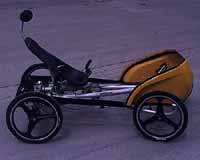The criticism of the rigid tricycle format, which most velomobiles are based on, comes from the limited stability when cornering sharply at speed. The trike usually has the advantage of a mechanically elegant and simple steering or drive, comparable to a bicycle, with additional stability provided by the third wheel. On snow, ice and loose ground the trike is very stable when compared to a bike, as it will slide rather than fall. On hard ground however the bike has the advantage, being able to lean into curves. As a result the industry is beginning serious exploration of alternative designs with the potential to overcome this limitation.
 Some designs and ideas were presented at the recent Velomobile Seminar. One solution is to take the mechanically simple trike layout and “improve” it by adding some kind of tilting function to counter the overturning force. For example the new VeloTilt design. There are arguments for and against, and challenges to over come but development work is moving ahead. Another alternative is to add an extra wheel to gain the stability of a quadricycle as illustrated by the Quatro.
Some designs and ideas were presented at the recent Velomobile Seminar. One solution is to take the mechanically simple trike layout and “improve” it by adding some kind of tilting function to counter the overturning force. For example the new VeloTilt design. There are arguments for and against, and challenges to over come but development work is moving ahead. Another alternative is to add an extra wheel to gain the stability of a quadricycle as illustrated by the Quatro.
Four wheel velomobiles are not new. Indeed many of the early “pedal cars” were four-wheelers. Mochet’s Velocar was originally designed on the behest of his wife so that his son would have a stable machine, and therefore safe in her view, on which to go out riding with his friends. The recumbent advantage was only discovered by accident as it were, once the Velocar was being used alongside other cycles.
An increasing number of modern quadricycles are starting to make an appearance some with velomobile features. One-such is the Zampano by Designwerks from Germany. At least one prototype has been produced and is illustrated here. Designwerks website is professionally produced in German, but there is little information on the present status of the project, or what if any plans there are for manufacture and sale.
Based on Google Translate the Zampano website states:
This innovative vehicle combines the benefits of the bicycle, car and public transport in one product without being unnecessarily burdened by their disadvantages. It consists of aluminum and high-tech materials such as carbon fiber, Makrolon and Goretex, is powered completely emission-free, has no parking spaces, is all-weather-resistant and also encloses its users. … Depending on the version an option for an electric motor will be available this fall. The time is ripe for a solution like this.
The German text also makes reference to a Manfred Klauda and Tretauto GmbH Munchen. If anyone can add more information please do so in the comments below.


The late Manfred Klauda was at one time the importer of Berkut velomobiles from Russia – and an all round interesting chap, who ran the ‘Centre for Unusual Museums’.
http://de.wikipedia.org/wiki/Manfred_Klauda
Berkut are currently not actively commercially but they still answer emails AFAIK and info is still up at:
http://www.berkut-trikes.com/en_faired_trike.html
Hello Peter, and thanks for the link. Sad to read that he passed away as the result of a traffic accident! You mention he imported Berkut velomobiles from Russia. I was under the impression from their website that they only produced 2 prototypes in 1996 and no more, but perhaps something was lost in translation.
Forgot to say that one of the unusual museums he ran was a pedalcar museum, hence his interest perhaps.
Pingback: A Velomobile Concept with a Fabric Skin | Velomobiles
Why is it that a person over 77 of age can’t find something like to get around in , with battery assist and that don’t cost over $3000.00 ?
Largely because batteries are expensive, especially the lighter kind with the performance required to sustain multiple discharge cycles. If you are looking for a hybrid human-electric system, you still have to watch the weight, can you pedal it when the batteries are flat? Weight saving also costs. If you limit yourself just to a human powered vehicle however, (I assume your complain applies to electric mobility scooters as well as HPVs) there is a problem that there just isn’t enough people of 77 years age or older or younger that are “looking” for such a vehicle, which means the market is limited to the current crop of suppliers who hand-build a limited number of machines at “hand-built” prices for what are either: early adopters; or people who can justify the cost by savings elsewhere, e.g. by ditching a car/automobile.
At sub $3,000 you are in the market for a good used machine but you would still face having to spend likely $1,000+ for new batteries to replace the old.